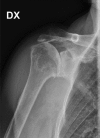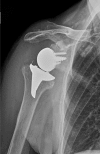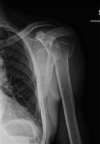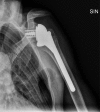Cementless metaphyseal reverse shoulder arthroplasty: our preliminary experience
- PMID: 30714998
- PMCID: PMC6503425
- DOI: 10.23750/abm.v90i1-S.8064
Cementless metaphyseal reverse shoulder arthroplasty: our preliminary experience
Abstract
Reverse shoulder arthroplasty (rTSA) is a largely used procedure with a wide variety of indications. The incidence of this surgery is increased in recent years and the literature expects similar trend for them future. Metaphyseal stem rTSA seems to be a promising solution considering major objectives the preservation of humeral bone stock and ease of revision. In our study we analyzed 19 patients treated with cementless metaphyseal stem rTSA for osteoarthritis (group A) and acute fractures (group B). In group A (7 patients) the average Constant score improved from 21,57 (16-29) to 56,85 (38-72), the average SST improved from 2,29 (1-4) to 9,43 (8-12) and the mean VAS score improved from 14,29 to 4,86. In group B (12 patients) the mean Constant-Murlay score at last follow up was 42,17; the average SST was 7 and average pain score was 8,92. Overall active range-of-motion (ROM) improved significantly. Surgical considerations, clinical (analyzing Constant score and Simple Shoulder Test) and radiological short-term outcomes are encouraging, with low rate of complications. Long term follow-up studies are necessary to confirm our findings and the potential benefits related to these implants.
Figures
References
-
- Pabinger C, Geissler A. Utilization rates of hip arthroplasty in OECD countries. Osteoarthritis Cartilage. 2014;22(6):734–41. - PubMed
-
- Pabinger C, Lothaller H, Geissler A. Utilization rates of knee-arthroplasty in OECD countries. Osteoarthritis Cartilage. 2015;23(10):1664–73. - PubMed
-
- Schairer WW, Nwachukwu BU, Lyman S, Creig EV, Gulotta LV. National utilization of reverse total shoulder arthroplasty in the United States. J Shoulder Elbow Surg. 2015;24(1):91–7. - PubMed
-
- Villacis D, Sivasundaram L, Pannell WC, Heckmann N, Omid R, Hatch GF 3rd. Complication rate and implant survival for reverse shoulder arthroplasty versus total shoulder arthroplasty: results during the initial 2 years. J Shoulder Elbow Surg. 2016;25(6):927–35. - PubMed
MeSH terms
LinkOut - more resources
Full Text Sources
Medical





